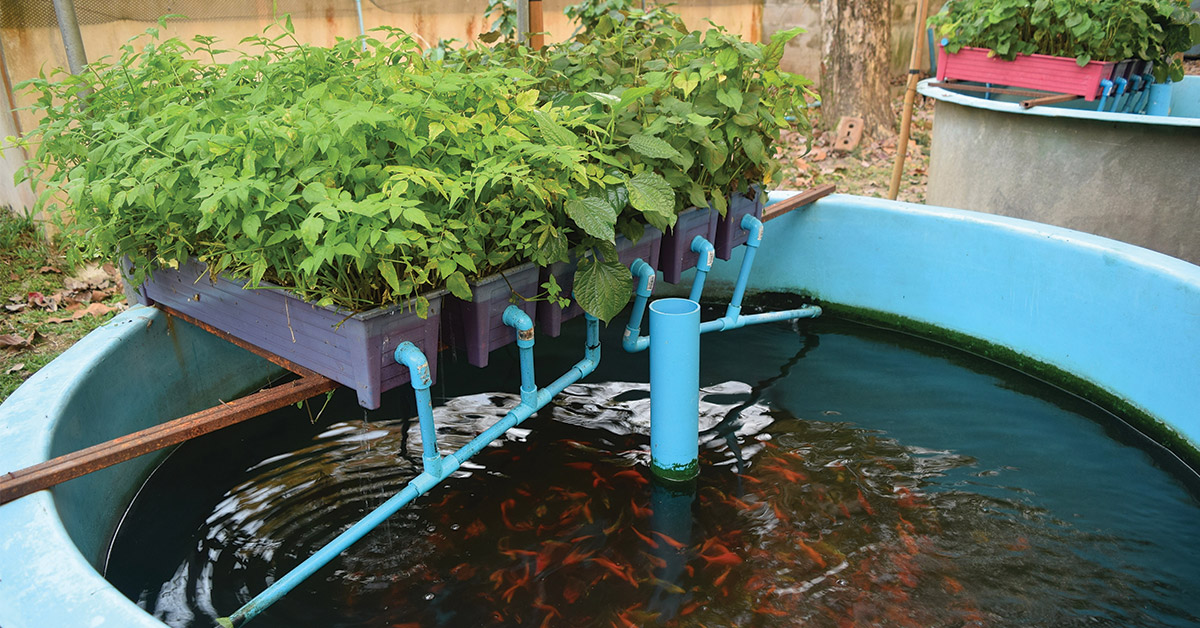
Koi ponds are considered some of the most tranquil and enjoyable ways to use your backyard space…
Most koi hobbyists do not consider how to use their pond more effectively, for fish health and for their personal benefit by using aquaponics.
What is aquaponics? Aquaponics is officially defined as, “the combination of two principal growing processes working in harmony to deliver one, self-sustained system” (Veludo, Hughes, and Le Blan, 2012). It is the combo of hydroponics, the process of growing plants that are suspended in liquid, without the added nutrients from the soil, with nutrients created from koi fish waste. Together, this process creates a natural feed for the plants.
Aquaponics is sustainable, healthy, and a family fun activity. When compared to traditional farming, aquaponics requires 90% less water (Shelley, 2018). It is an incredibly sustainable method to produce food at home with little cost.
Aquaponics is also much more healthy than normal farming methods, as plants are able to get their nitrogen from bacteria in the water, not the fertilizer in the soil that is loaded with chemicals to give the same effect.
Practicing aquaponics is a fun way for everyone in the family to get outside, learning about the growth of sustainable food and to enjoy your yard.
But are Japanese koi a good choice to use in your aquaponics system? Let us dive deeper into this pond of knowledge!
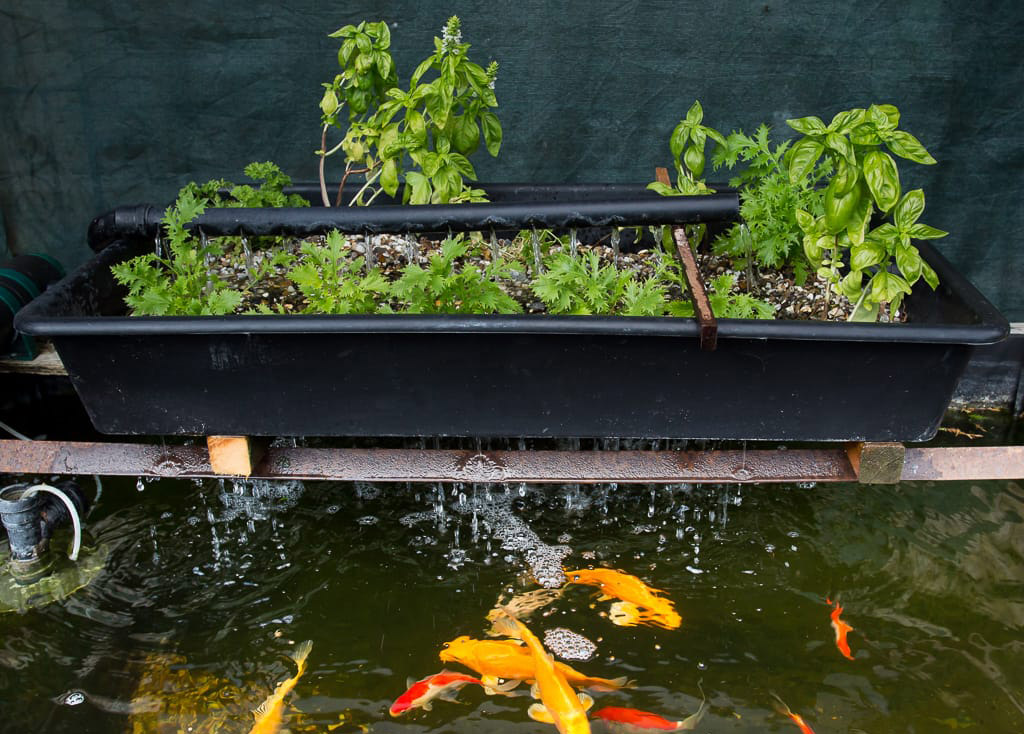
Image from https://aquapona.co.uk/aquaponic-gardening/
Can You Use Koi for Aquaponics?
While there are multiple species of fish that can be used in aquaponics, we believe koi are the most ideal for a multitude of reasons.
Koi have been bred for centuries into the living jewels that they are today. Only in the past decade, have people realized their potential for use in aquaponics. Koi also offer a great nutrient source, as they are constantly eating a range of feed and expelling high quality nutrients for exceptional plant growth.
We recommend you use young koi in your aquaponics system, as they can be easier to handle and produce less waste than some of the bigger, more mature koi. If you plan to use aquaponics with a pond full of mature koi, make sure they are not creating too much waste for the bacteria, by checking pond water clarity and parameters often, especially in the start of the project.
Top Reasons Why Koi Are Great For Aquaponics Systems:
1. Wide Water Temperature Range: While koi thrive in temperatures between 40 and 70 degrees Fahrenheit, they are suitable in water temps between 35 and 80 degrees. Little to no heating of the water will be required to keep the koi healthy, unlike many other species that can also be used for aquaponics. This not only reduces your monthly heating bill, but is also much more sustainable.
2. Waste: Koi produce more than an ample amount of waste for bacteria to convert for plant growth. Koi also enjoy being fed small amounts of feed multiple times throughout the day which creates more consistent waste. “Koi are the best species for creating nutrients in an aquaculture system – such as ammonia, magnesium, and potassium; all essential for healthy plant growth” (Ward, 2020).
3. Feed: Koi have very long intestines making them able to consume and convert a wide range of food into nutrients. Unlike other species, they are able to feed on plant matter, koi feed, and even algae in the water. This lowers your cost for feed, and allows the koi to be eating and producing waste at all times.
4. Resistance to Disease: Koi are resistant to disease, which is observed in their ability to thrive in a wide range of water quality and water temperatures. Note: If your koi develops a disease, you must use a bypass pipe or disconnect your grow beds from the circulating water, so that the plants do not receive anything from the medicated koi food.
5. Wide pH Range: While you always want to keep your koi pond within a reasonable pH range, it is helpful that koi live in an ideal pH range for aquaponics.

Why Should I Use a Koi Aquaponics System?
Koi aquaponic systems have many benefits with very few down sides.
Koi aquaponics is both cheap to set up and also delivers more savings down the line. It is very easy to add an aquaponics system to an existing pond, something that is very intriguing for many hobbyists. Hobbyists will find themselves spending less money on water and general koi feed, especially when using their crops to supplement some of the koi feed.
For anyone considering starting their first koi pond or adding on to an existing one, here is why you should really consider an aquaponics system.
Easy Aquaponics Koi Setup
For everyone that is considering adding an aquaponics system to their koi pond- don’t worry! Lucky for you, it is very easy to add an aquaponics system to an existing pond. There are two main activities for setting up an aquaponics system.
- Grow Beds: Buying or building your own grow bed is the most important step in the process. This is where the plants you are growing will sit either on top of, in the water, or near your koi pond. For more information on getting the best grow bed for your koi pond, check out a related article on grow beds by Nick Brooke.
- Split Pump: Next, you will need to split the flow of water from your existing pond pump to now include your grow beds. This will allow fresh water to flow between your pond and grow beds freely, recycling the water and adding nutrients.
Chemical/ Pesticide Free
Aquaponics is a very sustainable and healthy way to not only keep your pond clean and healthy, but also to be able to grow your own vegetables and fruits. Unlike much of the produce grown in our society today that is showered in a long list of chemicals and pesticides, you are not able to use any of these in your aquaponics system because they are highly toxic to koi. The natural process that the plants use to get their nutrients from nitrates in an aquaponics system is a much healthier alternative.
No Pollution In Closed Loop System
Koi waste is used as nutrients by the plants and in turn do not need any toxic chemicals to stay healthy, aquaponics is a closed loop system. In other words, “no pollution of the environment by either fish waste or chemical pollutants” (Bernstien, 2011). Everything remains in the system and thus it is a more sustainable model.
Less Water Use
Whether you are starting your first pond or adding an aquaponics system to your current pond, get ready to start saving water. Because aquaponic systems naturally clean the water, your water inputs are much less than typical koi ponds. You will find yourself only adding small amounts to recoup water loss through evaporation and transpiration. Who doesn’t love both sustainable and cost effective practices?
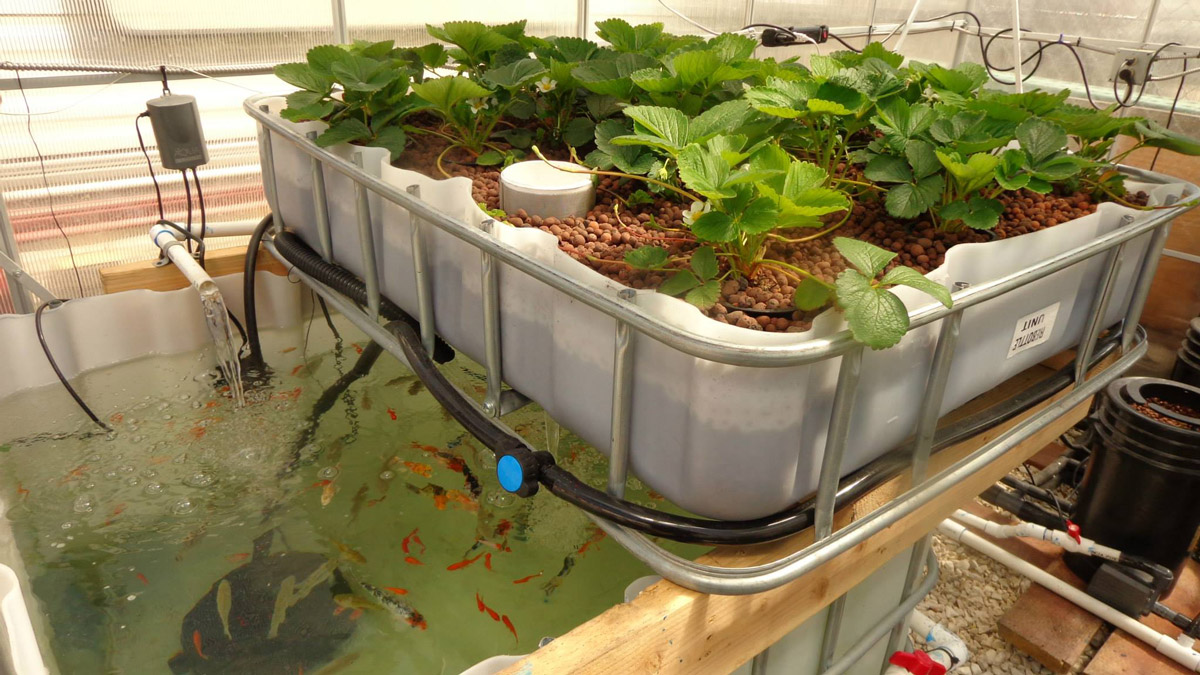
Image source: https://iotworld.co/talapia-koi-aqua-ponics/
Constructing Your Koi Aquaponic System
There are a few key items you will need to invest in when building your first aquaponic system.
A strong aquaponics system contains a grow bed that is able to support both your plants, the media they sit in, and the water passing through.
- Grow Beds: Grow beds should be around 15 inches in height, with the ability for 12 inches of the bed to be underwater.
- Grow Media: Your plants will be sitting in the media, as it acts as soil. Some of the most common grow media include clay pebbles, river rock, and lava rock (Brooke, 2020).
- PVC Piping: This is how you will connect your pond and grow bed.
- Bell Syphon: A bell syphon sits in the grow bed, automatically draining water when the levels get too high. Once the water has dropped back down again, air flow re-enters the syphon and stops the drain. The continuous rise and fall of the water level is great for spreading nutrients and breaking down koi waste. The best part is: no power supply is needed!
- Split Pump Bypass: Install a bypass pipe so you are able to work directly with the koi needs, and not have to worry about water getting into your grow bed system. This is important if you ever have to medicate your koi due to disease outbreak, it is not good to get the medicine or chemicals into the food you are growing.
Read our koi health diagnosis article to learn more about the symptoms and recommended treatments that are essential for maintaining a healthy koi pond.
VIDEO: How to Build an Aquaponic Pond System
What Fruits/ Vegetables are Best for Aquaponics?
When deciding what you would like to grow in your aquaponics system, it is important to consider how much nutrients are being created in your pond. This directly relates to the stock density of your pond, as more koi means more nutrients that are able to be created and subsequently used by the vegetation.
The most common fruits and vegetables used in aquaponics include: Lettuce, Herbs, Water Spinach, Chives, Basil, Watercress, Tomatoes, Bell Peppers, Cucumbers, Mint, Beans, Peas, Squash, Broccoli, Cauliflower, and Cabbage.
To start your first aquaponics system, you may want to begin with water spinach. In a study comparing water spinach and lettuce growth, they saw quantifiable results from water spinach outgrowing lettuce. They cited water spinach having more leaf blades and being able to absorb more nitrogen and nutrients (Andriani, Zahidah, Dhahiyat, Hamdani and Dewi, 2019).
If you want quantity from your aquaponics system, we recommend you grow water spinach.
Tips For Your Aquaponics Koi Pond
- For a successful pond, check these parameters: dissolved oxygen, carbon dioxide, ammonia, nitrate, nitrite, and pH. With changes in stock density, growth rates, feed rates, or water volume, check these above parameters frequently (Yildiz, Robaina, Pirhonen, Mente, Domínguez and Parisi, 2017).
- Check your pH regularly, especially in the beginning! The nitrification process that produces nutrients for your plants will lower the pH in the pond.
- Remove plants when treating your pond for disease or parasites, as many of these chemicals are toxic for your plants.
- Watch out for aquatic turtles in your koi aquaponics, as they can carry salmonella (Ecolife, 2016).
- Feed your koi in smaller increments at least two times a day, this will create the most optimal nutrients for your plants.
- The bigger the koi, the bigger the waste. Make sure if you are adding an aquaponics system to a pond with heavily stocked, large koi, that you clean the pond frequently to make sure no extra waste is accumulating.
- Grow your vegetables or fruits in the summer! Unlike in the summer, a koi’s metabolism slows down in the winter, requiring only one feeding per day and thus creating less nutrients (Brooke, 2020). If you want to get the most out of your aquaponics, do it during warmer months.
Read our koi pond winter survival guide to prepare yourself for successful colder months and see how others are handling the cold!
Why Choose Koi Aquaponics?
Ultimately, choosing an aquaponics koi system gives much more than koi owners originally anticipate. Beyond the beauty of using your koi fish to help produce food, you all will have a lot of other psychological benefits of koi aquaponics.
Koi aquaponics allows you to produce organically grown fruits and vegetables for use in your meals, impress friends and family with system knowledge, create an extremely sustainable system, make your backyard greener, save money and take advantage of nature’s life cycle.
Build the system and help save the planet by farming at home and using a system that naturally cleans the water for you, leading to way less personal water use for your koi.
Read the benefits of owning a pond and learn why so many people are creating backyard paradises.
Please comment below with your own experiences in koi aquaponics and let us know any questions we did not answer in this article to help you with your pond management.
References
Andriani, Y., ., Z., Dhahiyat, Y., Hamdani, H., & Dewi, D. (2019). Performance of Lettuce and Water Spinach in Koi Fish-based Aquaponics System. Asian Journal of Fisheries and Aquatic Research,1-7. doi:10.9734/ajfar/2019/v3i430039 Link: https://www.journalajfar.com/index.php/AJFAR/article/view/30039
Bernstein, S. (n.d.). Aquaponic Gardening: A Step-by-Step Guide to Raising Vegetables and Fish Together. New Society Publishers. Link: http://www.iked.org/pdf/Aquaponics.pdf
Brooke, N. (2020). Aquaponics Growbeds – A Beginners Guide – HowtoAquaponic. Retrieved from https://www.howtoaquaponic.com/designs/aquaponics-growbeds/ Link:https://www.howtoaquaponic.com/designs/aquaponics-growbeds/
Diver, S., & Rinehart, L. (2010). Aquaponics – Integration of Hydroponics with Aquaculture. Retrieved from https://attra.ncat.org/attra-pub/summaries/summary.php?pub=56 Link: https://attra.ncat.org/attra-pub/summaries/summary.php?pub=56
Shelley, T. (2018, April 08). Nasty Truth: Aquaponics vs. Traditional Farming. Retrieved from https://www.survivopedia.com/nasty-truth-aquaponics-vs-traditional-farming/ Link: https://www.survivopedia.com/nasty-truth-aquaponics-vs-traditional-farming/
Veludo, M., Hughes, A., & Le Blan, B. (2012, December). Introduction to Aquaponics: A Key to Sustainable Food Production. Retrieved from http://iked.org/pdf/Aquaponics.pdf Link:http://www.iked.org/pdf/Aquaponics.pdf
Ward, S. (2020, May 20). Koi Fish for Aquaponics: What You Need to Know. Retrieved from https://worldwaterreserve.com/aquaponics/koi-fish-aquaponics/ Link: https://worldwaterreserve.com/aquaponics/koi-fish-aquaponics/
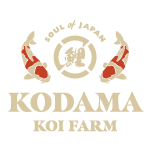
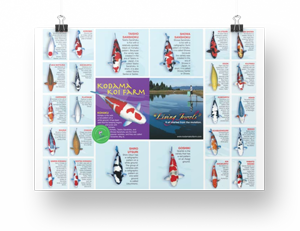

hi
thanks for giving great information. keep posting.
best vegetable and fruits supplier in hyderabad
Thks for those precious informations. Once the koi is big enough is it fine to sell them as a complementary income ?
Do u think that immersion speaker with classical music could reduce the stress of the koi ?
🙏🏼
I know some people will sell their koi online when they need to move or discontinue their pond. Depends on what type of buyers you find, you could become successful.
Music to help destress koi, that is an interesting suggestion. Have not tried it yet, the vibrations could have some type of effect on the koi. The most effective way to alter a kois behavior is through their environment.
Hello, thanks for your advices, very helpful. Do you still need a UV lamp in this system?
You may put one to help stabilize the algae growth
Here is a UV light that we offer https://www.kodamakoisupply.com/shop/periha-drop-in-uv-light/